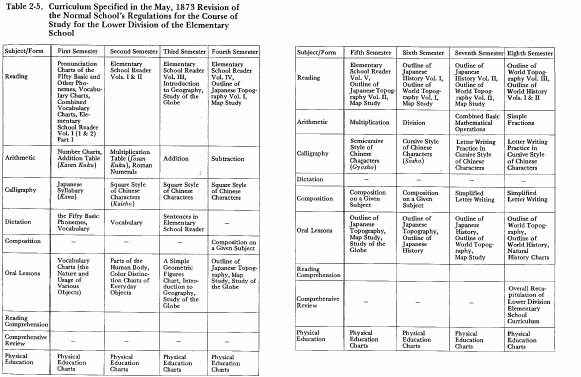- 現在位置
- トップ > 白書・統計・出版物 > 白書 > JAPAN'S MODERN EDUCATIONAL SYSTEM > b. Curricula and Textbooks
b. Curricula and Textbooks
Reforms of the method and content of education became topics of great urgency following the proclamation of the Education System Order. In October, 1872, one month after the Order's proclamation, the Department of Education issued its 1872 Regulations for the Course of Study for Elementary Schools (Shogaku Kyosoku). These Regulations made clear the basic policy for curriculum and teaching methods, providing for two levels of courses of the elementary school each divided into eight forms of six months each. Pupils were to attend classes every day except Sundays for five hours a day or thirty hours per week. Spelling, calligraphy, words pronunciation, arithmetic, oral instruction in morals and words recitation were to be taught for the first semester, and many subjects based on Western models were to be gradually added to as the pupils were promoted to the senior levels; textbooks graded according to form level also were referred to. The Regulations thus promoted a great change from the simple curriculum of the terakoya constituted of reading, writing and abacus and also from the teaching subjects offered by the fief schools (hanko or hangaku). For the most part, the textbooks for these Western subjects were direct translations of foreign texts. Despite the good intentions, the theory behind these school reforms was clearly inappropriate for the actual conditions in Japan of the I87Os. Traditional educational practices could not be abandoned so easily.
When it became evident that the original desk plans were inappropriate, the Department of Education had the Normal School, which was under its direct control, undertake the preparation of new regulations for elementary education. Among the teachers of this School was an American named Marion M. Scott (1843-1922), who had been invited to Japan for consultation and research into the actual conditions of Japanese elementary education. The Normal School compiled new regulations for the course of study for each of the two divisions of the elementary school. The lower division regulations were drawn up in February, 1873, which were revised in May of that same year; and the upper division regulations appeared in May, 1873. The May, 1873 revision of the lower division regulations recommended offering the nine subjects of reading, arithmetic, calligraphy, dictation, composition, oral lessons (mondo), reading comprehension, comprehensive review and physical education. Special attention was given to reading, arithmetic, calligraphy and oral lessons. This curriculum was a compromise between the old terakoya program and the modern concept of schooling envisioned by the Department of Education, The subject listed as oral lessons was in effect a synthesis of science, geography, history and morals. Later this subject was differentiated into these distinct subjects.
The Department of Education accepted the Normal School's regulations for the course of study for elementary schools as the standard for the elementary school curriculum and set forth a policy by which to ensure its dissemination. Thereafter many prefectures took these regulations as a model for their own purposes. Graduates of Tokyo Normal School (renamed from the Normal School in July, 1873) carried these new ideas in education to the normal schools in various prefectures and, in a brief period of time, assured the adoption of the curriculum at many progressive elementary schools throughout the country.
Table 2-5. Curriculum Specified in the May, 1873 Revision of the Normal School's Regulations for the Course of Study for the Lower Division of the Elementary School

As we have already noted, the Department of Education in its 1872 Regulations for the Course of Study for Elementary Schools clearly specified the curriculum in these schools and also referred to textbooks for each semester and for each subject. Through examining these textbooks, we can obtain a good idea of the kind of education it had in mind for the modern elementary school. A large proportion of the textbooks were either translations or new books published after the Meiji Restoration. Often these works had not been written specifically for use as textbooks, but rather were intended for the general reader. Hence from an early date the Department began the practice of editing elementary school textbooks (An Editorial Section (Henshuryo) was set up within the Department in October, 1871, shortly after its establishment and began immediately to translate and edit textbooks.).
The Normal School, which was under the direct jurisdiction of the Department of Education, was also requested to compile elementary school textbooks on the basis of its practical experience. Also an office for editing elementary school textbooks was set up in the Normal School in December, 1872.
The Department of Education encouraged independent prefectures to reprint the textbooks and other educational material which it and the Normal School had compiled, and it was not long before most of the prefectures adopted this practice and the reprinted textbooks were in nationwide use. Especially following the establishment of regulations for the course of study for elementary schools by the Normal School the textbooks prepared by this institute gained wide acceptance. These textbooks included elementary school readers, introductory geography, outlines of Japanese topography, outlines of world topography, outlines of Japanese history, outlines of world history, elementary school arithmetic, etc. Some private groups also developed popular textbooks. In addition to textbooks the Normal School took the lead in developing teaching aids such as the pronunciation charts of the fifty basic and other phonemes, vocabulary and combined vocabulary charts, addition and multiplication tables, a simple geometric figures chart with its attached solid models, and color distinction charts. The elementary school textbooks proved to be an interesting introduction of the new knowledge based on the Civilization and Enlightenment (Bunmeikaika) thought, and they were accepted not only as textbooks but also as popular reading material for the public at large. Thus their influence was of considerable importance in the dissemination of the new culture.
お問合せ先
(C)COPYRIGHT Ministry of Education, Culture, Sports, Science and Technology
-- 登録:平成21年以前 --